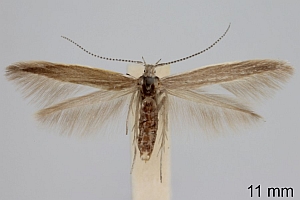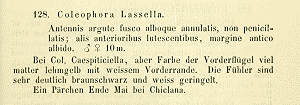

 +29Kontinente:EUASAF
+29Kontinente:EUASAF2. Diagnose
2.1. Geschlecht nicht bestimmt
2.2. Erstbeschreibung
3. Biologie
3.1. Nahrung der Raupe
- [Juncaceae:] Juncus bufonius (Kröten-Binse)
Nach Emmet et al. (1996) lebt die Art in Südwest-Frankreich (Gironde) an der Kröten-Binse (Juncus bufonius). Von dieser Pflanze gibt es auch mehrere Angaben aus Dorset (Großbritannien): [hantsmoths.org.uk] zeigt mehrere am 26. Juli 1975 an dieser Pflanze ("Toad Rush") gesammelte Säcke und [leafmines.co.uk] zeigt einen Sack mit Sammeldatum 26. Juli 1993; dort ist zu erfahren: "The case is made from a seed capsule and the larvae consume the contents of a capsule before attaching it to another one to feed. The final case is shown and is 4-5mm long. The tepals of the capsule will extend this a further 0.5 - 2mm."
4. Weitere Informationen
4.1. Andere Kombinationen
- Ecebalia lassella (Staudinger, 1859) [so bei Anikin et al. (2017)]
4.2. Synonyme
- Coleophora teidensis Walsingham, [1908]
- Coleophora gotlandica Benander, 1939
- Coleophora telavivella Toll, 1942
4.3. Faunistik
Die Art ist in Europa weit verbreitet.
Nach Gaedike & Heinicke (1999) in Deutschland nur mit Angaben von vor 1980 aus Schleswig-Holstein, Sachsen und Sachsen-Anhalt bekannt. Gaedike et al. (2017) können zu keinem der drei Bundesländer neuere Funde melden, wohl aber auf die Arbeit von Biesenbaum & Seliger (2008) verweisen, in der über einen aktuellen Erstnachweis aus Nordrhein-Westfalen berichtet wird.
(Autor: Erwin Rennwald)
4.4. Typenmaterial
Baldizzone (1994: 151) designierte einen Lectotypus: “Lectotypus ♂ [designato in questa sede] conservato al MHUB, reca le seguenti etichette: 1) “Origin.” (rosa a stampa), 2) “Chiclana” (a mano), 3) “Präparat No 294 Gr.v.Toll”, (a mano e stampa), 4) “Zool.Mus.Berlin” (a stampa).”
4.5. Literatur
- Anikin, V.V., Sachkov, S.A. & V.V. Zolotuhin (2017): "Fauna lepidopterologica Volgo-Uralensis": from P. Pallas to present days. — Proceedings of the Museum Witt Munich, Volume 7: 1-696; Munich and Vilnius.
- Anikin, V. V. & V. I. Shchurov (2001): Casebearers from Caucasus (Lepidoptera: Coleophoridae). — Zoosystematica Rossica 10 (1): 171-179.
- Lectotypus-Festlegung: Baldizzone, G. (1994): Contribuzioni alla conoscenza dei Coleophoridae LXXV. Coleophoridae dell'Area Irano-Anatolica e regioni limitrofe (Lepidoptera). — Associazione Naturalistica Piemontese Memorie 3: 1-423. Stenstrup (Apollo Books).
- Biesenbaum, W. & R. Seliger (2008): Nachträge zu: Kleinschmetterlinge (Microlepidoptera) der Nordeifel und angrenzender Gebiete unter besonderer Berücksichtigung des Kreises Euskirchen. 3. Nachtrag. — Melanargia, 20 (4): 103-108.
- Emmet, A.M., Langmaid, J.R., Bland, K.P., Corley, M.F.V. & J. Razowski (1996): Coleophoridae. - S. 126-338. In: Emmet, A.M. [Hrsg.](1996): The moths and butterflies of Great Britain and Ireland. Volume 3. Yponomeutidae - Elachistidae. - 452 S.; Colchester, Essex.
- Gaedike, R. & W. Heinicke (1999): Verzeichnis der Schmetterlinge Deutschlands (Entomofauna Germanica 3). — Entomologische Nachrichten und Berichte, Beiheft 5: 1-216.
- Gaedike, R., Nuss, M., Steiner, A. & R. Trusch (2017): Verzeichnis der Schmetterlinge Deutschlands (Lepidoptera). 2. überarbeitete Auflage. — Entomologische Nachrichten und Berichte (Dresden), Beiheft 21: 1-362.
- Richter, I. (2017): New findings of the case-bearing moth genus Coleophora from the Balkan Peninsula with the description of Coleophora vardarella sp. nov. (Lepidoptera: Coleophoridae). — Microlepidoptera.hu 12: 83-94. [PDF auf oszk.hu] bzw. [ganzes Heft: PDF auf oszk.hu]
- Erstbeschreibung: Staudinger, O. (1859): Diagnose nebst kurzen Beschreibungen neuer andalusischer Lepidopteren. — Entomologische Zeitung 20 (7-9): 211-259. Stettin.

































